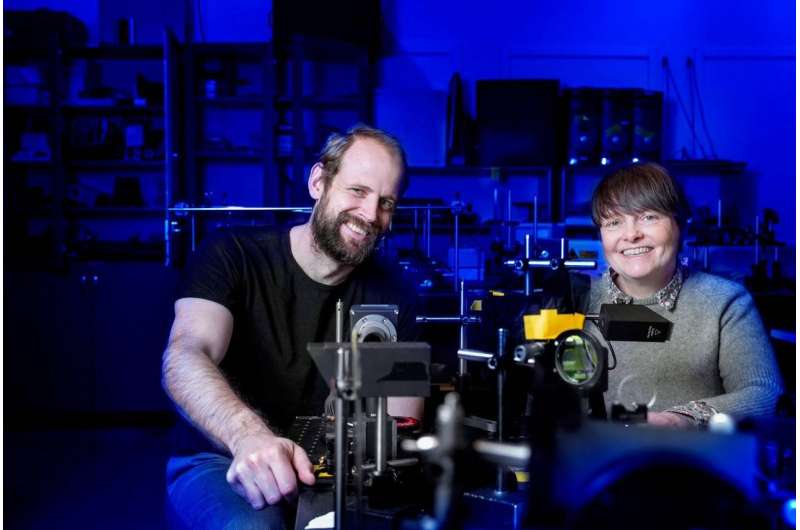Study the effect of long-term oxygen deficiency

Researchers at Luleå University of Technology have developed a method to study how muscle cells in the blood vessels of the lung permanently contract because of long-term oxygen deficiency. This phenomenon leads to increased pressure in the vessels of the lung and the strain on the heart increases. The effect is evident in lung diseases such as chronic obstructive pulmonary disease (COPD) and the prevailing COVID-19 pandemic; insufficient oxygen exchange due to disturbed lung function can lead to death during infections.
"It is not completely mapped out how increased pressure in the vessels of the lung is created under prolonged oxygen shortage, but it can lead to an overload of the right heart side and ultimately heart failure. We hope that our method can help to measure the signals from muscle cells in the blood vessels of the lung to better understand this process in the cells. Then you have more opportunity to develop drugs that can prevent the disease state or even cure it," says Kerstin Ramser, professor of experimental mechanics at Luleå University of Technology.
Ramser and Joel Wahl at Luleå University of Technology, in collaboration with researchers at Justus Liebig University in Giessen (Germany) from the Cardio Pulmonary Institute (CPI), have developed a method to study what happens in muscle cells in the pulmonary arteries in cases of prolonged oxygen deficiency.
Increases the risk of heart failure
In the normal case of lung-healthy people, oxygen-poor blood is transported from the body to the right side of the heart, which then pumps it out to the lungs via the pulmonary arteries for oxygenation. Our smooth muscle cells in the pulmonary arteries have the task of changing shape depending on oxygen content so that the arteries in the lung can either pass through blood—then they are relaxed—or not—when they are dense—so that oxygen uptake can be optimized in the best way, so-called Hypoxic Pulmonary Vasoconstriction (HPV). However, this process can become irreversible during prolonged oxygen deficiency in the lungs, so that the arteries in large parts of the lungs are dense all the time. The pressure in the pulmonary arteries then becomes abnormally high, because the same volume of blood tries to push through narrow vessels, a condition called called pulmonell hypertension. As a result, the right ventricle of the heart must compensate for the increased resistance, which in the end, due to constant work overload, can result in heart failure.
Measurement systems for cardiovascular experts
How the signaling system works in these muscle cells and what it is that causes an increased pressure in the vessels of the lung is not currently fully mapped and treatments are limited. The goal of the Luleå researchers is to develop measurement systems so that experts in cardiovascular disease can examine the function of the pulmonary arteries under oxygen deficiency, and produce much-needed drugs.
"We do not yet know exactly where in the cell it starts when the blood vessels in the lung permanently contract, but we are one step toward finding out. With our method, we have been able to see how the cells of a pulmonary artery communicate by seeing how the signals from individual molecules increase or decrease in response to oxygen deficiency. We are unique in being able to study shape change and molecular changes simultaneously at the individual cell level under controlled oxygen deficiency in muscle cells," Kerstin Ramser says.
To investigate this, the two researchers use so-called Raman scattering in combination with microfluidics and the patch clamp technique. With the help of a gas-tight flow chamber that gives full control over the oxygen content, they could simultaneously measure the oxygen content, how signal molecules (calcium and potassium) signal through cell walls and how the redox mechanisms of cell mitochondria behave.
With this method, they have been able to observe and image individual living muscle cells from pulmonary arteries whose molecules change depending on the oxygen content. They illuminated the muscle cells with laser light, whereby changes in the molecular composition of the cell could be detected. They observed how the proportion of biomolecules that are important for the energy production of cells increases and decreases as a response to lack of oxygen. The patch clamp technique involves a thin glass pipette containing an electrode that, once applied, is sucked onto the cell wall. Through the electrode, they observed how calcium ions flow through the cell membrane as a result of oxygen changes.
"A major challenge has been to deal with a noisy environment, where liquid fluids pass through living muscle cells in the microfluidic system where they are subjected to rapid but carefully controlled oxygen changes. At the same time, we are interested in measurement results from methods that are not directly compatible, which means that we constantly have to make compromises so as not to exclude important information. So it's not an easy measurement situation," Joel Wahl says
New target: measure and film the signals in real time
The two researchers at Luleå University of Technology have now gone on to develop a measurement system that combines three-dimensional (3-D) holographic imaging with stimulated Raman scattering (SRS).This method produces an effect many times stronger than the conventional Raman spectroscopy, which allows the biomolecular processes and shape changes in the cell to be measured in real time.
The article with the results is published in Science Advances, titled "Bypassing mitochondrial complex III using alternative oxidase inhibits acute pulmonary oxygen sensing."
More information: Natascha Sommer et al. Bypassing mitochondrial complex III using alternative oxidase inhibits acute pulmonary oxygen sensing, Science Advances (2020). DOI: 10.1126/sciadv.aba0694
Journal information: Science Advances
Provided by Lulea University of Technology


















